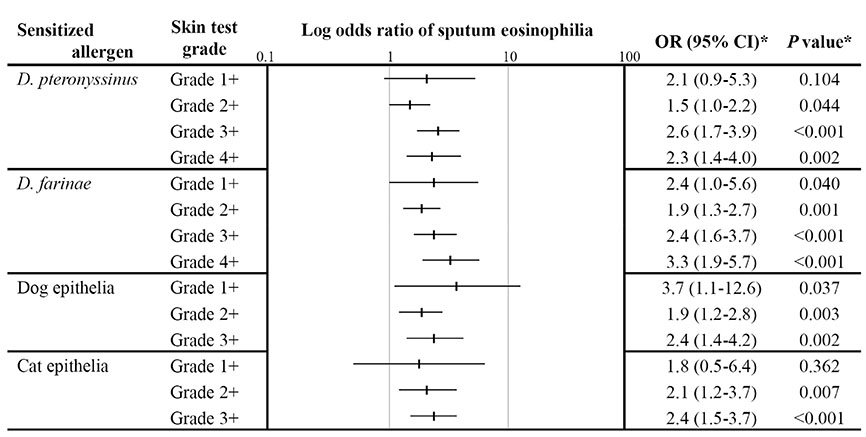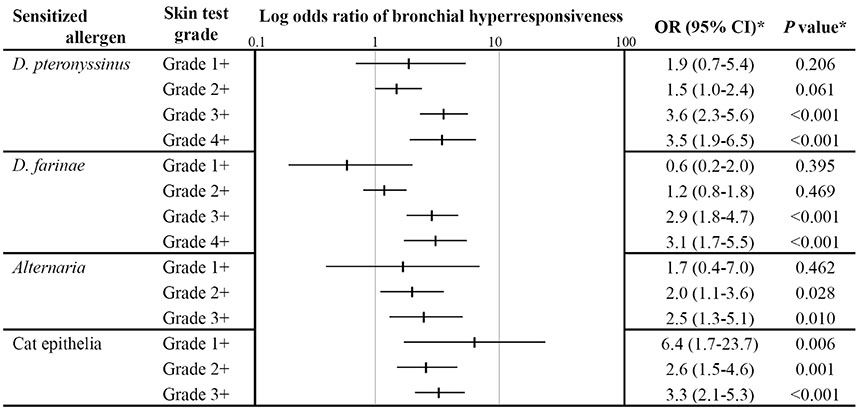Allergy Asthma Immunol Res.
2014 Jan;6(1):39-46. 10.4168/aair.2014.6.1.39.
Eosinophilic Airway Inflammation and Airway Hyperresponsiveness According to Aeroallergen Sensitization Pattern in Patients With Lower Airway Symptoms
- Affiliations
-
- 1Department of Internal Medicine, Seoul National University College of Medicine, Seoul, Korea. shkrins@gmail.com
- 2Institute of Allergy and Clinical Immunology, Seoul National University Medical Research Center, Seoul, Korea.
- 3Department of Internal Medicine, Seoul National University Bundang Hospital, Seongnam, Korea.
- KMID: 2166928
- DOI: http://doi.org/10.4168/aair.2014.6.1.39
Abstract
- PURPOSE
Sensitization to specific allergens may be important in the development of allergic airway inflammation and airway hyperresponsiveness (AHR). We evaluated the effect of specific aeroallergen sensitization on eosinophilic airway inflammation and AHR.
METHODS
We reviewed retrospectively the clinical data of subjects who underwent skin prick tests to aeroallergens, induced sputum analysis, and methacholine bronchial provocation tests to evaluate lower airway symptoms as well as analyzed the associations between the pattern of aeroallergen sensitization and sputum eosinophilia or AHR.
RESULTS
Of the 1,202 subjects be enrolled, 534 (44.4%) were sensitized to at least one aeroallergen in skin tests. AHR was demonstrated in 23.5% and sputum eosinophilia in 38.8%. Sputum eosinophilia was significantly associated with sensitization to perennial allergens (OR, 1.9; 95% CI, 1.4-2.5), house dust mite (OR, 1.7; 95% CI, 1.3-2.3), dog (OR, 1.9; 95% CI, 1.1-3.3), and cat (OR, 2.1; 95% CI, 1.4-3.4). AHR was associated with sensitization to perennial allergens (OR, 2.7; 95% CI, 2.0-3.7), house dust mite (OR, 2.2; 95% CI, 1.6 3.2), Alternaria (OR, 2.3; 95% CI, 1.2-4.7), and cat (OR, 2.7; 95% CI, 1.7-4.3). Sensitization to more perennial allergens increased the risk for sputum eosinophilia and AHR. There was no relationship with individual seasonal allergens.
CONCLUSION
The development of airway eosinophilic inflammation and AHR in an adult Korean population was associated with sensitization to perennial allergens rather than seasonal allergens.
MeSH Terms
Figure
Cited by 1 articles
-
Association Between Sensitization to Mold and Impaired Pulmonary Function in Children With Asthma
Jung Hye Byeon, Soohyun Ri, Oyuntulga Amarsaikhan, Eunji Kim, So Hyun Ahn, Ic Sun Choi, Hyung Jin Kim, SungChul Seo, Wonsuck Yoon, Young Yoo
Allergy Asthma Immunol Res. 2017;9(6):509-516. doi: 10.4168/aair.2017.9.6.509.
Reference
-
1. Levetin E, Van de Water P. Environmental contributions to allergic disease. Curr Allergy Asthma Rep. 2001; 1:506–514.2. Platts-Mills TA, Blumenthal K, Perzanowski M, Woodfolk JA. Determinants of clinical allergic disease. The relevance of indoor allergens to the increase in asthma. Am J Respir Crit Care Med. 2000; 162:S128–S133.3. Dreborg S. Impact of allergen exposure on bronchial hyperresponsiveness. Pediatr Allergy Immunol. 1996; 7:14–17.4. Brightling CE. Clinical applications of induced sputum. Chest. 2006; 129:1344–1348.5. Chung KF. Role of inflammation in the hyperreactivity of the airways in asthma. Thorax. 1986; 41:657–662.6. Alvarez MJ, Olaguibel JM, García BE, Rodríquez A, Tabar AI, Urbiola E. Airway inflammation in asthma and perennial allergic rhinitis. Relationship with nonspecific bronchial responsiveness and maximal airway narrowing. Allergy. 2000; 55:355–362.7. Corren J. Allergic rhinitis and asthma: how important is the link? J Allergy Clin Immunol. 1997; 99:S781–S786.8. Jaakkola MS, Ieromnimon A, Jaakkola JJ. Are atopy and specific IgE to mites and molds important for adult asthma? J Allergy Clin Immunol. 2006; 117:642–648.9. Arruda LK, Vailes LD, Ferriani VP, Santos AB, Pomés A, Chapman MD. Cockroach allergens and asthma. J Allergy Clin Immunol. 2001; 107:419–428.10. Chinn S, Heinrich J, Antó JM, Janson C, Norbäck D, Olivieri M, Svanes C, Sunyer J, Verlato G, Wjst M, Zock JP, Burney PG, Jarvis DL. Bronchial responsiveness in atopic adults increases with exposure to cat allergen. Am J Respir Crit Care Med. 2007; 176:20–26.11. Sears MR, Herbison GP, Holdaway MD, Hewitt CJ, Flannery EM, Silva PA. The relative risks of sensitivity to grass pollen, house dust mite and cat dander in the development of childhood asthma. Clin Exp Allergy. 1989; 19:419–424.12. Omenaas E, Bakke P, Eide GE, Elsayed S, Gulsvik A. Serum house dust mite antibodies: predictor of increased bronchial responsiveness in adults of a community. Eur Respir J. 1996; 9:919–925.13. Boulet LP, Turcotte H, Laprise C, Lavertu C, Bédard PM, Lavoie A, Hébert J. Comparative degree and type of sensitization to common indoor and outdoor allergens in subjects with allergic rhinitis and/or asthma. Clin Exp Allergy. 1997; 27:52–59.14. Craig TJ, King TS, Lemanske RF Jr, Wechsler ME, Icitovic N, Zimmerman RR Jr, Wasserman S. National Heart, Lung, and Blood Institute's Asthma Clinical Research Network. Aeroallergen sensitization correlates with PC(20) and exhaled nitric oxide in subjects with mild-to-moderate asthma. J Allergy Clin Immunol. 2008; 121:671–677.15. Oh JW, Lee HB, Kang IJ, Kim SW, Park KS, Kook MH, Kim BS, Baek HS, Kim JH, Kim JK, Lee DJ, Kim KR, Choi YJ. The revised edition of Korean calendar for allergenic pollens. Allergy Asthma Immunol Res. 2012; 4:5–11.16. Sohn SW, Lee HS, Park HW, Chang YS, Kim YK, Cho SH, Kim YY, Min KU. Evaluation of cytokine mRNA in induced sputum from patients with allergic rhinitis: relationship to airway hyperresponsiveness. Allergy. 2008; 63:268–273.17. Langley SJ, Goldthorpe S, Craven M, Morris J, Woodcock A, Custovic A. Exposure and sensitization to indoor allergens: association with lung function, bronchial reactivity, and exhaled nitric oxide measures in asthma. J Allergy Clin Immunol. 2003; 112:362–368.18. Tepas EC, Litonjua AA, Celedón JC, Sredl D, Gold DR. Sensitization to aeroallergens and airway hyperresponsiveness at 7 years of age. Chest. 2006; 129:1500–1508.19. Verdiani P, Di Carlo S, Baronti A. Different prevalence and degree of nonspecific bronchial hyperreactivity between seasonal and perennial rhinitis. J Allergy Clin Immunol. 1990; 86:576–582.20. Mete N, Sin A, Gulbahar O, Erdinc M, Sebik F, Kokuludag A. The determinants of bronchial hyperresponsiveness in patients with allergic rhinitis. Ann Allergy Asthma Immunol. 2004; 93:193–199.21. Kerkhof M, Postma DS, Schouten JP, de Monchy JG. Allergic sensitization to indoor and outdoor allergens and relevance to bronchial hyperresponsiveness in younger and older subjects. Allergy. 2003; 58:1261–1267.22. Peat JK, Tovey E, Mellis CM, Leeder SR, Woolcock AJ. Importance of house dust mite and Alternaria allergens in childhood asthma: an epidemiological study in two climatic regions of Australia. Clin Exp Allergy. 1993; 23:812–820.23. Downs SH, Mitakakis TZ, Marks GB, Car NG, Belousova EG, Leüppi JD, Xuan W, Downie SR, Tobias A, Peat JK. Clinical importance of Alternaria exposure in children. Am J Respir Crit Care Med. 2001; 164:455–459.24. Nelson HS. The importance of allergens in the development of asthma and the persistence of symptoms. J Allergy Clin Immunol. 2000; 105:S628–S632.25. Pallasaho P, Rönmark E, Haahtela T, Sovijärvi AR, Lundbäck B. Degree and clinical relevance of sensitization to common allergens among adults: a population study in Helsinki, Finland. Clin Exp Allergy. 2006; 36:503–509.26. Patelis A, Gunnbjörnsdottir M, Malinovschi A, Matsson P, Onell A, Högman M, Alving K, Janson C. Population-based study of multiplexed IgE sensitization in relation to asthma, exhaled nitric oxide, and bronchial responsiveness. J Allergy Clin Immunol. 2012; 130:397–402.e2.27. Chinn S, Burney P, Sunyer J, Jarvis D, Luczynska C. Sensitization to individual allergens and bronchial responsiveness in the ECRHS. European Community Respiratory Health Survey. Eur Respir J. 1999; 14:876–884.28. Djukanović R, Feather I, Gratziou C, Walls A, Peroni D, Bradding P, Judd M, Howarth PH, Holgate ST. Effect of natural allergen exposure during the grass pollen season on airways inflammatory cells and asthma symptoms. Thorax. 1996; 51:575–581.29. Zanolin ME, Pattaro C, Corsico A, Bugiani M, Carrozzi L, Casali L, Dallari R, Ferrari M, Marinoni A, Migliore E, Olivieri M, Pirina P, Verlato G, Villani S, Marco R. ISAYA Study Group. The role of climate on the geographic variability of asthma, allergic rhinitis and respiratory symptoms: results from the Italian study of asthma in young adults. Allergy. 2004; 59:306–314.30. Garcia-Marcos L, Garcia-Hernández G, Morales Suarez-Varela M, Batlles Garrido J, Castro-Rodriguez JA. Asthma attributable to atopy: does it depend on the allergen supply. Pediatr Allergy Immunol. 2007; 18:181–187.31. Beggs PJ. Impacts of climate change on aeroallergens: past and future. Clin Exp Allergy. 2004; 34:1507–1513.32. Sohn MH, Kim KE. The cockroach and allergic diseases. Allergy Asthma Immunol Res. 2012; 4:264–269.33. Yong TS, Jeong KY. Household arthropod allergens in Korea. Korean J Parasitol. 2009; 47:Suppl. S143–S153.34. Sakashita M, Hirota T, Harada M, Nakamichi R, Tsunoda T, Osawa Y, Kojima A, Okamoto M, Suzuki D, Kubo S, Imoto Y, Nakamura Y, Tamari M, Fujieda S. Prevalence of allergic rhinitis and sensitization to common aeroallergens in a Japanese population. Int Arch Allergy Immunol. 2010; 151:255–261.35. Platts-Mills TA, Heymann PW, Longbottom JL, Wilkins SR. Airborne allergens associated with asthma: particle sizes carrying dust mite and rat allergens measured with a cascade impactor. J Allergy Clin Immunol. 1986; 77:850–857.36. Schappi GF, Taylor PE, Pain MC, Cameron PA, Dent AW, Staff IA, Suphioglu C. Concentrations of major grass group 5 allergens in pollen grains and atmospheric particles: implications for hay fever and allergic asthma sufferers sensitized to grass pollen allergens. Clin Exp Allergy. 1999; 29:633–641.37. Kauffman HF. Interaction of environmental allergens with airway epithelium as a key component of asthma. Curr Allergy Asthma Rep. 2003; 3:101–108.38. D'Amato G, Cecchi L, Bonini S, Nunes C, Annesi-Maesano I, Behrendt H, Liccardi G, Popov T, van Cauwenberge P. Allergenic pollen and pollen allergy in Europe. Allergy. 2007; 62:976–990.39. Reed CE, Kita H. The role of protease activation of inflammation in allergic respiratory diseases. J Allergy Clin Immunol. 2004; 114:997–1008.40. Shakib F, Schulz O, Sewell H. A mite subversive: cleavage of CD23 and CD25 by Der p 1 enhances allergenicity. Immunol Today. 1998; 19:313–316.41. Gunawan H, Takai T, Ikeda S, Okumura K, Ogawa H. Protease activity of allergenic pollen of cedar, cypress, juniper, birch and ragweed. Allergol Int. 2008; 57:83–91.42. Holgate ST. Airway inflammation and remodeling in asthma: current concepts. Mol Biotechnol. 2002; 22:179–189.43. Tomee JF, van Weissenbruch R, de Monchy JG, Kauffman HF. Interactions between inhalant allergen extracts and airway epithelial cells: effect on cytokine production and cell detachment. J Allergy Clin Immunol. 1998; 102:75–85.44. Hassim Z, Maronese SE, Kumar RK. Injury to murine airway epithelial cells by pollen enzymes. Thorax. 1998; 53:368–371.45. Rosenstreich DL, Eggleston P, Kattan M, Baker D, Slavin RG, Gergen P, Mitchell H, McNiff-Mortimer K, Lynn H, Ownby D, Malveaux F. The role of cockroach allergy and exposure to cockroach allergen in causing morbidity among inner-city children with asthma. N Engl J Med. 1997; 336:1356–1363.46. Simpson JL, McElduff P, Gibson PG. Assessment and reproducibility of non-eosinophilic asthma using induced sputum. Respiration. 2010; 79:147–151.47. Fleming L, Tsartsali L, Wilson N, Regamey N, Bush A. Sputum inflammatory phenotypes are not stable in children with asthma. Thorax. 2012; 67:675–681.
- Full Text Links
- Actions
-
Cited
- CITED
-
- Close
- Share
- Similar articles
-
- Influential Factors Related to Association of Bronchial Hyperresponsiveness in Patient with Allergic Rhinitis
- Effects of CpG-oligodeoxynucleotides in Chronic Inflammation and Remodeling of Airway in a Murine Model of Bronchial Asthma
- Airway remodelling in asthma: role for mechanical forces
- Effect of Coexistence of Atopic Dermatitis on Eosinophilic Lower Airway Inflammation in Mild Persistent Asthma
- BCG infection during pre-sensitization or even post-sensitization inhibits airway sensitivity in an animal model of allergic asthma



